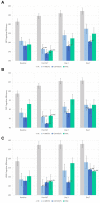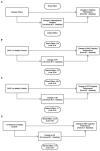Cognitive impairment in post-acute sequelae of COVID-19 and short duration myalgic encephalomyelitis patients is mediated by orthostatic hemodynamic changes
- PMID: 37434760
- PMCID: PMC10330752
- DOI: 10.3389/fnins.2023.1203514
Cognitive impairment in post-acute sequelae of COVID-19 and short duration myalgic encephalomyelitis patients is mediated by orthostatic hemodynamic changes
Abstract
Introduction: Cognitive impairment is experienced by people with myalgic encephalomyelitis/chronic fatigue syndrome (ME/CFS) and post-acute sequelae of COVID-19 (PASC). Patients report difficulty remembering, concentrating, and making decisions. Our objective was to determine whether orthostatic hemodynamic changes were causally linked to cognitive impairment in these diseases.
Methods: This prospective, observational cohort study enrolled PASC, ME/CFS, and healthy controls. All participants underwent clinical evaluation and assessment that included brief cognitive testing before and after an orthostatic challenge. Cognitive testing measured cognitive efficiency which is defined as the speed and accuracy of subject's total correct responses per minute. General linear mixed models were used to analyze hemodynamics and cognitive efficiency during the orthostatic challenge. Additionally, mediation analysis was used to determine if hemodynamic instability induced during the orthostatic challenge mediated the relationship between disease status and cognitive impairment.
Results: Of the 276 participants enrolled, 256 were included in this study (34 PASC, 71 < 4 year duration ME/CFS, 69 > 10 year ME/CFS duration, and 82 healthy controls). Compared to healthy controls, the disease cohorts had significantly lower cognitive efficiency scores immediately following the orthostatic challenge. Cognitive efficiency remained low for the >10 year ME/CFS 2 and 7 days after orthostatic challenge. Narrow pulse pressure less than 25% of systolic pressure occurred at 4 and 5 min into the orthostatic challenge for the PASC and ME/CFS cohorts, respectively. Abnormally narrow pulse pressure was associated with slowed information processing in PASC patients compared to healthy controls (-1.5, p = 0.04). Furthermore, increased heart rate during the orthostatic challenge was associated with a decreased procedural reaction time in PASC and < 4 year ME/CFS patients who were 40 to 65 years of age.
Discussion: For PASC patients, both their disease state and hemodynamic changes during orthostatic challenge were associated with slower reaction time and decreased response accuracy during cognitive testing. Reduced cognitive efficiency in <4 year ME/CFS patients was associated with higher heart rate in response to orthostatic stress. Hemodynamic changes did not correlate with cognitive impairment for >10 year ME/CFS patients, but cognitive impairment remained. These findings underscore the need for early diagnosis to mitigate direct hemodynamic and other physiological effects on symptoms of cognitive impairment.
Keywords: ME/CFS; cognitive impairment; long COVID; myalgic encephalomyelitis; orthostatic hemodynamic changes; post-acute sequelae of SARS-CoV-2 (PASC).
Copyright © 2023 Day, Yellman, Hammer, Rond, Bell, Abbaszadeh, Stoddard, Unutmaz, Bateman and Vernon.
Conflict of interest statement
The authors declare that the research was conducted in the absence of any commercial or financial relationships that could be construed as a potential conflict of interest.
Figures




Similar articles
-
Orthostatic Challenge Causes Distinctive Symptomatic, Hemodynamic and Cognitive Responses in Long COVID and Myalgic Encephalomyelitis/Chronic Fatigue Syndrome.Front Med (Lausanne). 2022 Jun 23;9:917019. doi: 10.3389/fmed.2022.917019. eCollection 2022. Front Med (Lausanne). 2022. PMID: 35847821 Free PMC article.
-
Orthostatic Symptoms and Reductions in Cerebral Blood Flow in Long-Haul COVID-19 Patients: Similarities with Myalgic Encephalomyelitis/Chronic Fatigue Syndrome.Medicina (Kaunas). 2021 Dec 24;58(1):28. doi: 10.3390/medicina58010028. Medicina (Kaunas). 2021. PMID: 35056336 Free PMC article.
-
Improvement of Long COVID symptoms over one year.Front Med (Lausanne). 2023 Jan 9;9:1065620. doi: 10.3389/fmed.2022.1065620. eCollection 2022. Front Med (Lausanne). 2023. PMID: 36698810 Free PMC article.
-
Exercise Pathophysiology in Myalgic Encephalomyelitis/Chronic Fatigue Syndrome and Postacute Sequelae of SARS-CoV-2: More in Common Than Not?Chest. 2023 Sep;164(3):717-726. doi: 10.1016/j.chest.2023.03.049. Epub 2023 Apr 11. Chest. 2023. PMID: 37054777 Free PMC article. Review.
-
Long COVID in pediatrics-epidemiology, diagnosis, and management.Eur J Pediatr. 2024 Apr;183(4):1543-1553. doi: 10.1007/s00431-023-05360-y. Epub 2024 Jan 27. Eur J Pediatr. 2024. PMID: 38279014 Free PMC article. Review.
Cited by
-
Core features and inherent diversity of post-acute infection syndromes.Front Immunol. 2025 Jun 3;16:1509131. doi: 10.3389/fimmu.2025.1509131. eCollection 2025. Front Immunol. 2025. PMID: 40529374 Free PMC article. Review.
-
Cardiorespiratory fitness is associated with cognitive function in late adulthood: baseline findings from the IGNITE study.Br J Sports Med. 2025 Feb 3;59(3):167-176. doi: 10.1136/bjsports-2024-108257. Br J Sports Med. 2025. PMID: 39658276 Free PMC article.
-
Cognitive Impairments in Two Samples of Individuals with ME/CFS and Long COVID: A Comparative Analysis.J Clin Psychol Med Settings. 2025 Mar 22. doi: 10.1007/s10880-025-10074-4. Online ahead of print. J Clin Psychol Med Settings. 2025. PMID: 40120036
-
Incidence and Prevalence of Post-COVID-19 Myalgic Encephalomyelitis: A Report from the Observational RECOVER-Adult Study.J Gen Intern Med. 2025 Apr;40(5):1085-1094. doi: 10.1007/s11606-024-09290-9. Epub 2025 Jan 13. J Gen Intern Med. 2025. PMID: 39804551 Free PMC article.
-
Microvascular Capillary and Precapillary Cardiovascular Disturbances Strongly Interact to Severely Affect Tissue Perfusion and Mitochondrial Function in Myalgic Encephalomyelitis/Chronic Fatigue Syndrome Evolving from the Post COVID-19 Syndrome.Medicina (Kaunas). 2024 Jan 23;60(2):194. doi: 10.3390/medicina60020194. Medicina (Kaunas). 2024. PMID: 38399482 Free PMC article.
References
-
- Baldwin N. L., Murray K. O., Garcia M. N., Bateman L. (2016). Treatment of postural orthostatic tachycardia syndrome and management of myalgic encephalomyelitis/chronic fatigue syndrome following suspected West Nile virus infection. Fatigue 4, 226–236. doi: 10.1080/21641846.2016.1247971 - DOI
Grants and funding
LinkOut - more resources
Full Text Sources
Miscellaneous

